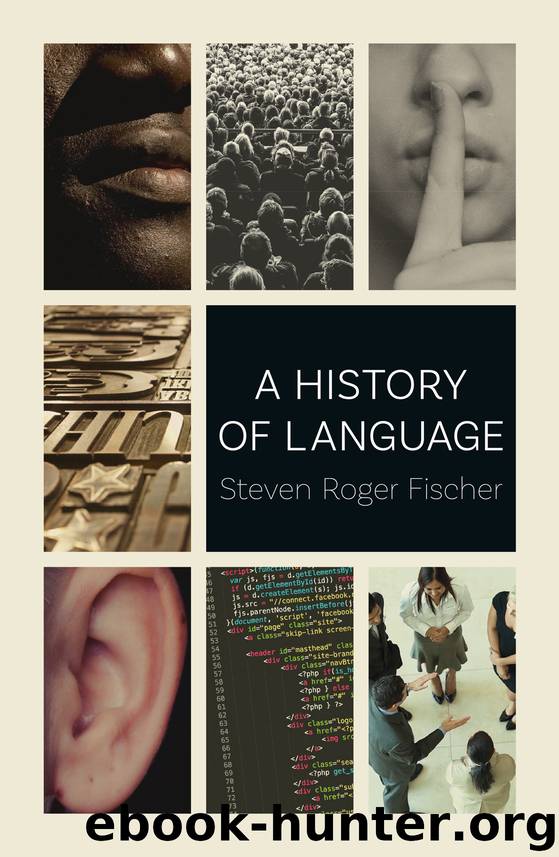A History of Language by Steven Roger Fischer

Author:Steven Roger Fischer
Language: eng
Format: epub
Publisher: Reaktion Books
CHINESE LANGUAGES
Chinese or Sinitic is the most easterly and important subfamily of the larger Sino-Tibetan family of languages.28 Its members are isolating languages – that is, their ‘word’ is generally a morpheme (the smallest meaningful unit of a language), with word order and/or special particles showing grammatical relationships. Unlike the Celtic, Germanic and Italic languages which only recently became isolating, Chinese has preserved its isolating status in all stages of its history. Probably less than 5,000 years ago, the first Sino-Tibetan speakers entered the Yellow River Valley to settle there permanently. Whom they met there – whose language then helped to create what came to be Chinese – remains unknown. It appears that a large part of the Chinese vocabulary, but not its grammar, may have been borrowed from these earlier inhabitants.
During the Zhou Dynasty (1050 to 220 BC), Chinese was spoken in a much more restricted area than at present. Its heartland was the Yellow River Plain. But already in the first millennium BC its domain expanded to the peripheries. Over centuries the conquest of ethnic neighbours imposed the Chinese language on those territories where one hears it today – similar to Latin in the west. Before the sixth century AD Old Chinese was spoken. Middle Chinese designates the language between the sixth and tenth centuries. Old Mandarin was heard from the tenth century to the middle of the fourteenth century (the beginning of the Ming Dynasty), Middle Mandarin from the fourteenth to the nineteenth centuries and Modern Mandarin from the beginning of the nineteenth century to the present.
Apart from the fact that Sinitic’s daughter, Mandarin Chinese, is spoken by more people as a first language than any other tongue on Earth, Chinese is one of the world’s very few contemporary languages (or language family) whose history is documented in writing in an unbroken tradition reaching back to the middle of the second millennium BC. At this time, during the Shang Dynasty (around 1700 to 1100 BC), divinatory texts on shell and bone were written in a language obviously related to that which was more copiously documented in the succeeding Zhou Dynasty. There is no doubt that this language of the Zhou Dynasty generated all later stages of Chinese, including the Chinese languages spoken today.
Because of Chinese’s logographic writing system (that is, non-alphabetic), the reconstruction of the pronunciation of even Middle Chinese logograms has been difficult, as the phonetic (sound) element is unclear. The reconstruction process has been aided by early Chinese rhyming dictionaries, which can help to reconstruct word endings and by comparing borrowings into Korean and Japanese which then identify word beginnings. Historical linguistic reconstruction has demonstrated that before the second century BC Old Chinese used consonantal clusters at the beginning of a word, but their precise nature is still unknown. In time these were reduced to single consonants, resulting in morphemes of the Chinese languages being words of one syllable. (Consonantal clusters survive at the end of words in a few Chinese languages.) Also, it has
Download
This site does not store any files on its server. We only index and link to content provided by other sites. Please contact the content providers to delete copyright contents if any and email us, we'll remove relevant links or contents immediately.
Cecilia; Or, Memoirs of an Heiress — Volume 1 by Fanny Burney(32434)
Cecilia; Or, Memoirs of an Heiress — Volume 2 by Fanny Burney(31871)
Cecilia; Or, Memoirs of an Heiress — Volume 3 by Fanny Burney(31856)
The Lost Art of Listening by Michael P. Nichols(7408)
Asking the Right Questions: A Guide to Critical Thinking by M. Neil Browne & Stuart M. Keeley(5636)
We Need to Talk by Celeste Headlee(5544)
On Writing A Memoir of the Craft by Stephen King(4863)
Dialogue by Robert McKee(4321)
Pre-Suasion: A Revolutionary Way to Influence and Persuade by Robert Cialdini(4150)
I Have Something to Say: Mastering the Art of Public Speaking in an Age of Disconnection by John Bowe(3840)
Elements of Style 2017 by Richard De A'Morelli(3307)
The Book of Human Emotions by Tiffany Watt Smith(3238)
Fluent Forever: How to Learn Any Language Fast and Never Forget It by Gabriel Wyner(3028)
Name Book, The: Over 10,000 Names--Their Meanings, Origins, and Spiritual Significance by Astoria Dorothy(2939)
Good Humor, Bad Taste: A Sociology of the Joke by Kuipers Giselinde(2903)
Why I Write by George Orwell(2874)
The Art Of Deception by Kevin Mitnick(2736)
The Grammaring Guide to English Grammar with Exercises by Péter Simon(2710)
Ancient Worlds by Michael Scott(2625)
